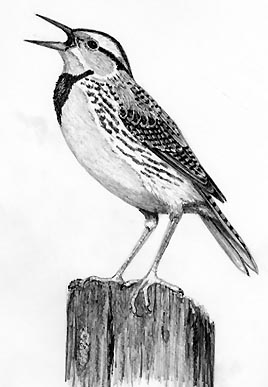
Dear Bird Folks,
I just came back from Fort Hill (in Eastham), where I think I saw a meadowlark. However, when I checked my bird book (Peterson Guide) for verification, meadowlarks weren’t in it. The only larks listed in the index were Horned Larks. How could the Peterson Field Guide to Birds omit such a common bird?
– Tina, Hartford, CT
Author’s note:
Last Sunday a woman (along with a few of her friends) came into my shop asking for help identifying a bird she had seen at Fort Hill. I helped her but, like a bonehead, I neglected to ask her name. So, for the sake of this column, I’ve decided to call her “Tina.” She didn’t necessarily look like a Tina, but it’s one of the few names I can spell. In other words, the above incident is real, but the name has been changed to protect the incompetent…me.
It’s there, Tina,
Even though Roger Tory Peterson has been dead for over twenty years, his bird books still include meadowlarks. He simply doesn’t list meadowlarks with the other larks. But before you start cursing Roger Tory, the person you probably should be upset with is Carl Linnaeus. Who is Carl Linnaeus? Carl was a Swedish zoologist and the first person to scientifically describe meadowlarks. Unfortunately, he thought our brown and yellow birds were related to the larks of Europe. It later turned out that the Swede was wrong, causing nearly as much confusion throughout the world as a set of IKEA instructions. Meadowlarks are not real larks, thus they are not found in the index under “L.” But rest assured, they are in your bird book. They are listed under “M” (for meadowlark). Now that I think about it, this problem is partly your fault, because meadowlark is only one word. So, looking for meadowlarks under “L” is like trying to find Killdeer by looking under “D.” I’m just saying. If meadowlarks aren’t real larks, what are they? It turns out meadowlarks are actually in the blackbird family. Blackbirds are a diverse family of birds that includes such species as those often-cursed grackles. While many folks may not be happy to see the grackles return, there is another blackbird they very much look forward to seeing. Those brilliant Baltimore Orioles that we all love so much are also in the blackbird family. So there.
For years it was thought that North America had one single meadowlark species, but then John James Audubon (another dead bird artist) pointed out that the Western birds sang differently than the birds in the East. (The Western songs have a hint of a drawl, while the Eastern birds rarely pronounce the letter R.) Even though the birds are nearly identical, their dissimilar songs suggested that the two birds are different. After years of debate, it turned out that old JJA was correct and the Eastern Meadowlark and Western Meadowlark were declared to be two distinct species. Today, the Western Meadowlark is one of the country’s most beloved birds. It is so popular that six states (Kansas, Montana, Nebraska, North Dakota, Oregon, and Wyoming) have selected it as their official state bird. Only the Northern Cardinal beats that total. At last count, the mega-popular cardinal has been declared the state bird of over seventy U.S. states. (Years ago, and this is 100% true, I made that same joke in one of our old catalogs. Several notables pointed out my “mistake,” including Consumer Reports and The Tonight Show, with Jay Leno. I’m only telling you this story, Tina, to point out that if Jay and Consumer Reports couldn’t figure out an obvious joke, you shouldn’t feel bad about confusing meadowlarks with true larks.)
Anyone living in suburbia may not be familiar with meadowlarks, but the folks who live near farmland or open country are likely to have a soft spot for these spirited, yellow-bellied birds. Each spring the males can be seen (and heard) singing from fence posts and wires. Their songs may be nostalgic to humans but this is a serious matter for the meadowlarks. The males, which typically have two and sometimes three mates at once, have to work hard to keep the rivals away. The females also have to work hard, as they alone do all of the nest construction and incubating of the eggs plus provide most of the food for the chicks. Occasionally, the male may also attend the chicks, but only if it’s okay with his other ladies.
Because I’m an ardent supporter of nature, people might be inclined to call me a “tree hugger,” but I’m not as crazy about trees as they might think. In fact, trees are actually choking out the Eastern meadowlarks. Here in Massachusetts, for example, far more of our undeveloped land is tree covered and only a small percentage is the grassy fields meadowlarks require. As a result, the local population of meadowlarks is in serious decline. For the sake of the meadowlarks, we need fewer tree lovers and a lot more grass lovers. (BTW, I’m not referring to the kind of “grass” that just became legal. That grass already has enough lovers.)
You were lucky to see a meadowlark at Fort Hill, Tina. That is one of the few places on the Cape this grassland loving bird is still occasionally seen. Finally, don’t worry about confusing meadowlarks with actual larks; we’ll just blame Carl Linnaeus. I never did like that guy.